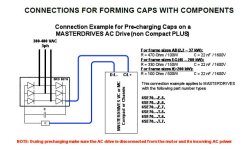So you are feeding the drive with low voltage AC then?
The 120V goes into the variac. The output of the variac is 0 - 120VAC. And that 'backfeeds' the control transformer. Normally the control transformer steps 575VAC single phase to 120VAC single phase.
But 20V into the output terminals gives about 90VAC out the high side of the transformer. Adjust the variac to get the DC bus voltage (after the diode bridge and the pre-charge resistor)you want. The capacitors that are being reformed are doing the filtering ... likely not ideal. But that's how we are told that our supplier does the VFDs that they have on their shelves (older stock).
As for the boards, the DC/DC converter that supplies the power to the electronics does not appear to function below 500V. Above 500VDC on the bus the electronics power up and give various warnings about Emergency Stop terminals not driven, low bus voltage, etc. Perhaps the power supply is actually AC to DC, as we must use R and S for the input. Using R and T or S and T works for charging up the DC bus, but never powers up the control boards.
Perhaps we are stressing the boards somehow.
I guess this is not a good general-purpose description. As you say, not all VFDs will work with this setup.
In my experience, the manufacturer goes a bit over-board with the safety pre-cautions and procedures, for everything in general. Reforming caps, Preventive maintenance checks, air-filter changes, etc. Your distrubutor/supplier/reseller .. whoever sold it to you .. may be a resource for a more practical method.





